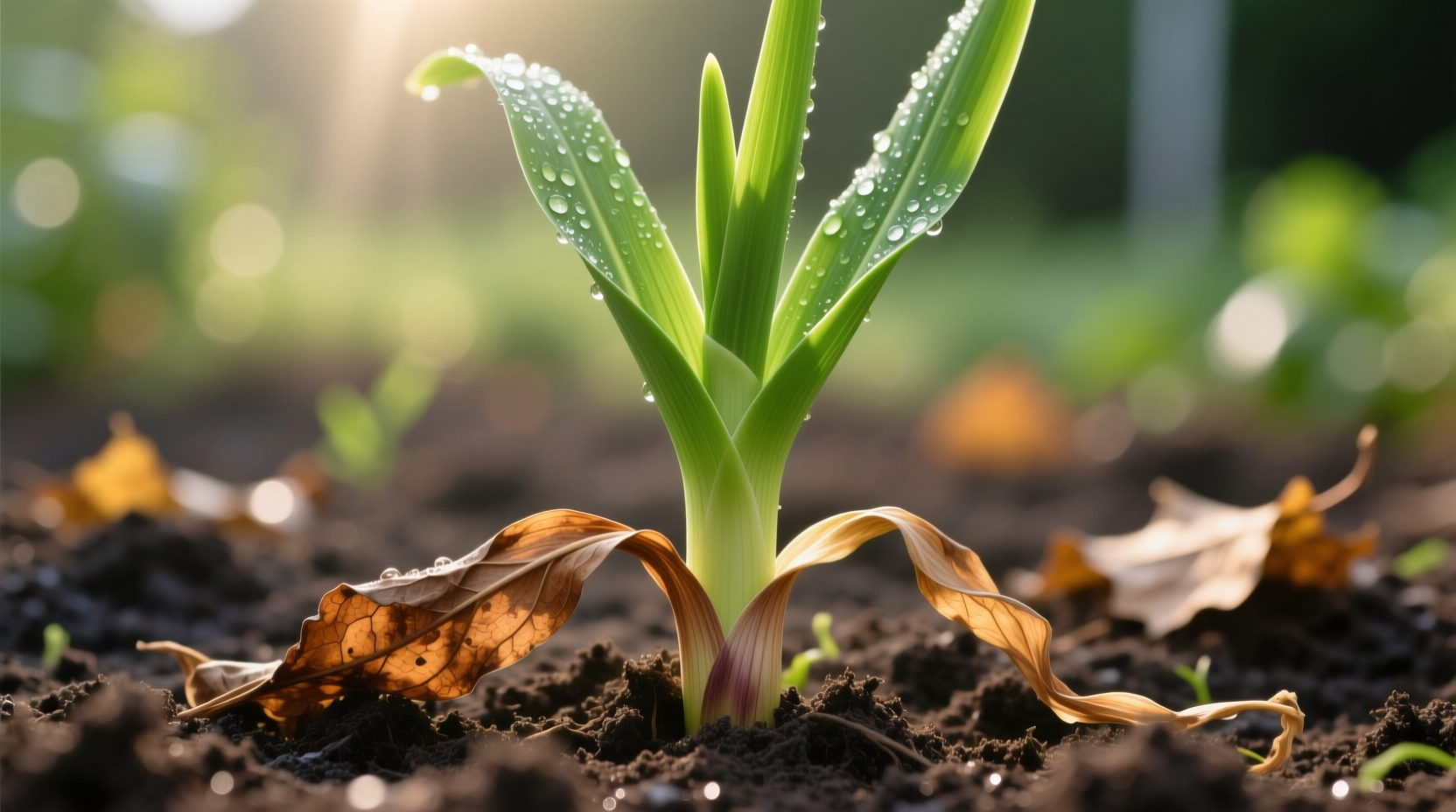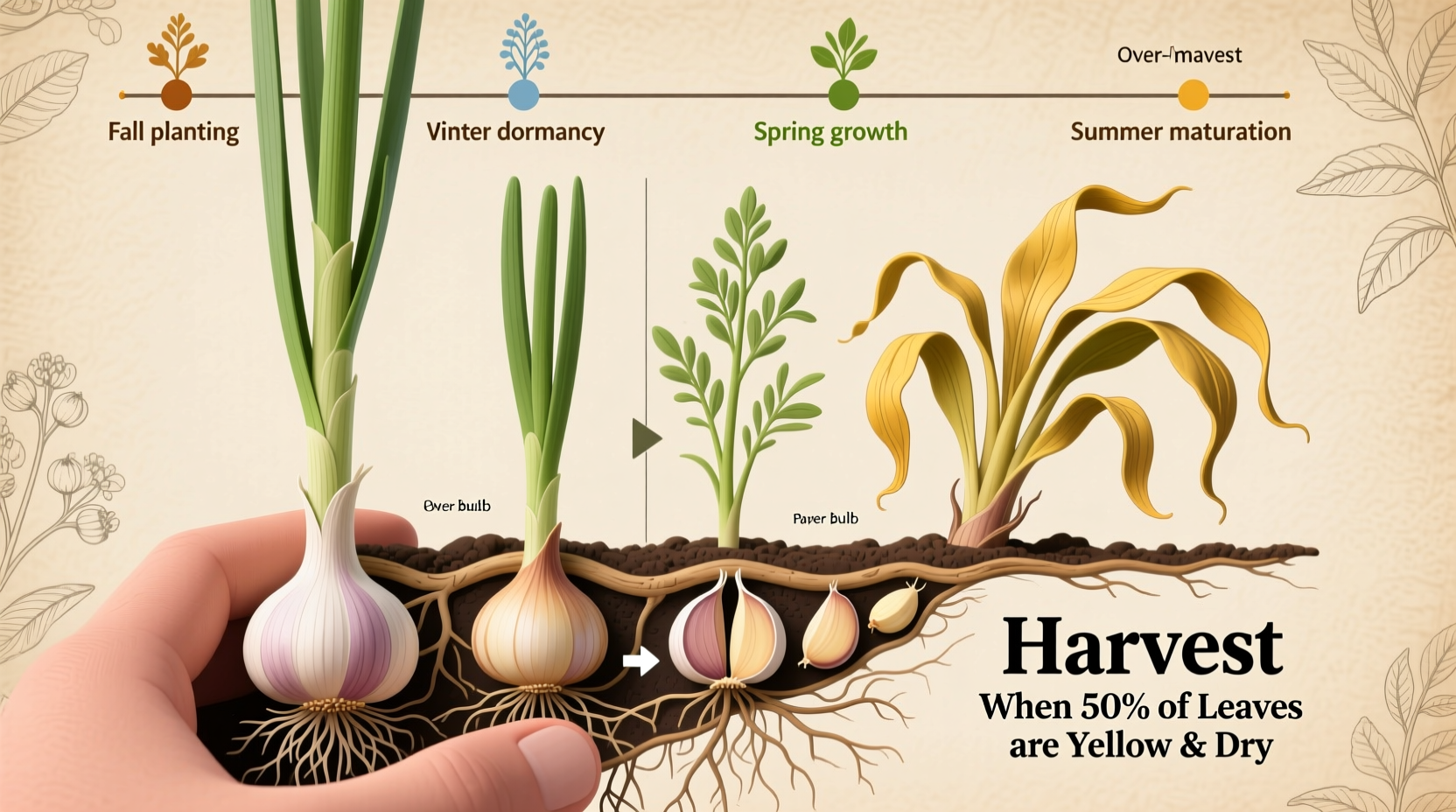Harvest garlic when 1/3 to 1/2 of the lower leaves turn brown while the upper leaves remain green—typically late spring to mid-summer depending on your climate. For hardneck varieties, harvest scapes when they form their first coil. Waiting for these visual cues ensures fully developed bulbs with proper wrapper integrity for long-term storage.
Getting the harvest timing right makes the difference between plump, well-formed garlic bulbs and disappointing results. As a gardener, you've nurtured your garlic through winter and spring growth—now it's time to reap the rewards of your patience. This guide delivers precise, actionable indicators so you'll never miss the perfect harvest window again.
Understanding Garlic's Growth Cycle
Garlic follows a predictable growth pattern that provides clear visual signals when harvest time approaches. Unlike many vegetables with fixed calendar dates, garlic requires observation of specific plant characteristics. The critical period begins when bulb formation completes and the plant shifts energy to maturing the protective wrappers around each clove.
| Garlic Growth Stage | Key Characteristics | Timeframe After Planting |
|---|---|---|
| Root Development | Initial root growth, minimal top growth | Fall (4-6 weeks after planting) |
| Leaf Production | Rapid leaf growth, 6-12 leaves visible | Winter through early spring |
| Bulb Initiation | Stem thickens, cloves begin forming | Early spring (when daylight reaches 12+ hours) |
| Bulb Maturation | Wrapper development, leaf dieback begins | Late spring to early summer |
| Harvest Readiness | 1/3-1/2 lower leaves browned, wrappers intact | When 30-50% leaf dieback occurs |
5 Visual Indicators Your Garlic Is Ready
1. The Leaf Color Threshold
Monitor the lower leaves closely as summer approaches. When approximately 30-50% of the lower leaves turn brown while the upper leaves remain green, your garlic has reached maturity. This ratio provides the most reliable indicator across all garlic varieties. Count the total leaves on a representative plant, then count how many have yellowed or browned from the bottom up.
2. Bulb Wrapper Integrity Check
Gently brush soil away from the top of a test bulb. The protective wrappers should be dry, papery, and intact but not deteriorated. If wrappers are splitting or appear deteriorated, you've waited too long. If they're still fleshy and white, the bulbs need more time to mature. Proper wrapper development is essential for long-term storage success.

3. Hardneck Garlic Scape Development
If growing hardneck varieties (which produce flower stalks), watch for scape formation. Harvest scapes when they complete their first full coil but before they straighten out. This typically occurs 2-4 weeks before bulb harvest. Removing scapes directs more energy to bulb development. For the bulbs themselves, harvest 2-4 weeks after scape removal when leaf dieback reaches the 30-50% threshold.
4. Soil Temperature Clues
Garlic matures when soil temperatures reach 75-80°F (24-27°C) at 4-inch depth for several consecutive days. This usually corresponds with the leaf dieback indicators. In cooler climates, this might occur in late June, while warmer zones may see readiness in May. Use a soil thermometer for precision, especially if your leaf indicators seem ambiguous.
5. Bulb Size Verification
For confirmation, carefully dig up one test bulb from your patch. Mature garlic bulbs should have distinct, well-formed cloves that fill out the wrapper. The cloves shouldn't be loose inside the wrapper (indicating over-maturity) nor tightly compressed (indicating immaturity). A mature bulb typically measures 1.5-3 inches in diameter depending on variety and growing conditions.
Regional Timing Considerations
Harvest timing varies significantly by climate zone. In northern regions (USDA zones 3-5), garlic typically matures in late July through August. Mid-latitude zones (6-7) see readiness in late June to mid-July. Southern growers (zones 8-10) often harvest in May or early June. Coastal areas may experience delayed maturation due to cooler temperatures. Always prioritize visual indicators over calendar dates, as unusual weather patterns can shift timing by 2-3 weeks.
Consequences of Incorrect Harvest Timing
Harvesting Too Early
When you pull garlic before it's fully mature, you'll encounter several issues: bulbs remain small with underdeveloped cloves, wrappers may be too thin for proper protection, and storage life dramatically decreases. Early-harvested garlic often continues growing in storage, producing sprouts that reduce quality. The flavor profile also remains milder than fully matured bulbs.
Harvesting Too Late
Waiting past peak maturity creates different problems: bulb wrappers deteriorate, cloves begin to separate and lose their tight formation, and the outer protective layers may rot. Over-mature garlic often has a stronger, sometimes bitter flavor and significantly reduced storage capability. In severe cases, bulbs may split open completely, making them vulnerable to disease and moisture damage.
Step-by-Step Harvesting Process
- Choose the right day: Harvest in the early morning during dry weather when soil is moderately moist (not wet)
- Loosen the soil: Use a garden fork to gently lift soil around bulbs, staying 4-6 inches from plants
- Lift carefully: Slide the fork under bulbs and lift gently to avoid bruising
- Handle properly: Never pull garlic by the leaves—this damages the neck and reduces storage life
- Clean gently: Brush off excess soil but avoid washing—moisture promotes rot during curing
- Preserve stems: Leave stems and roots intact for the curing process
Proper Curing and Storage Techniques
After harvest, cure garlic for 2-3 weeks in a warm, dry, well-ventilated space out of direct sunlight. Ideal conditions are 75-85°F (24-29°C) with 50-70% humidity. Braid softneck varieties or hang bulbs in mesh bags. Once cured, trim roots to 1/4 inch and stems to 1-2 inches. Store in a cool (55-65°F / 13-18°C), dark location with good air circulation. Properly cured and stored garlic maintains quality for 6-12 months depending on variety.
Common Harvest Mistakes to Avoid
Many gardeners make these critical errors: harvesting based solely on calendar dates rather than plant indicators, using excessive force that damages bulbs, washing garlic before curing, and storing in refrigerators or plastic bags. Remember that garlic continues to mature slightly after harvest, so slightly immature bulbs may finish developing during curing, but over-mature bulbs will only deteriorate further.











 浙公网安备
33010002000092号
浙公网安备
33010002000092号 浙B2-20120091-4
浙B2-20120091-4